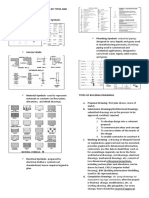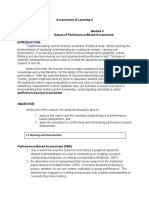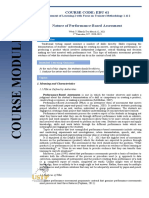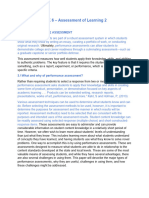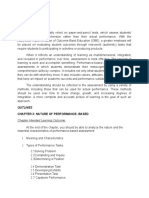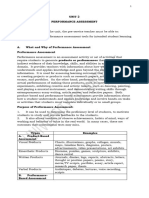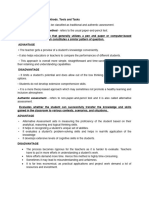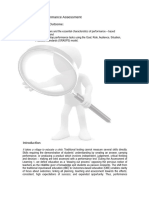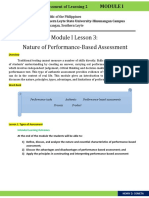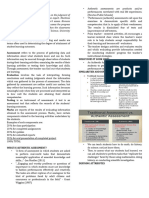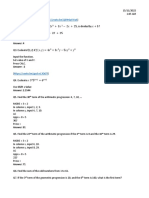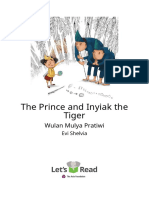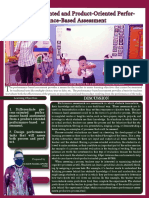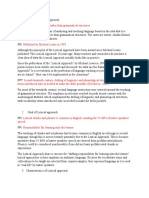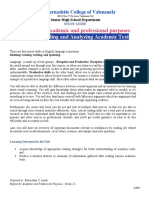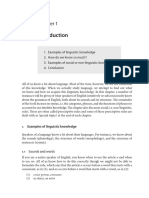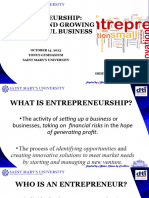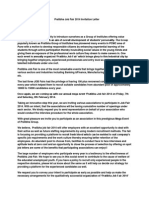Module 4
Module 4
Uploaded by
JOHNBCopyright:
Available Formats
Module 4
Module 4
Uploaded by
JOHNBOriginal Title
Copyright
Available Formats
Share this document
Did you find this document useful?
Is this content inappropriate?
Copyright:
Available Formats
Module 4
Module 4
Uploaded by
JOHNBCopyright:
Available Formats
Lesson 4
Performance Assessment
Strength and Limitations of Performance Assessment
Figure 4 A teacher observing her students performing a laboratory works- the performance of the student is being assessed
A ssessing of student performance can be applied through paper and pencil, observational using rubrics and behavioral
development. The teachers can assess the growth and development of students at various levels. Participation and involve-
ments of parents especially in the lower grades matters a lot. They are informed of the progress of their children in school. Also
the instructional supervisors are able to evaluate the strength and weaknesses of the academic program.
Reflective Questions REVIEW
•After showing involvement in Revisit the importance and process of performance assessment using concept
the topic, how do you see yourself map.
performed by the given task or
activity?
WHAT IS PERFORMANCE ASSESSMENT?
•Is paper and pencil effective to
you as a learner? If not, give an Performance Assessment is one which the teachers observes and makes a judg-
options ment about the student’s demonstration or skill of competency in creating a prod-
uct, constructing a response, or making a presentation. Performance is shorthand
•What is the importance of per- for performance-based or performance-and-product. Performance and product as-
formance assessment? sessment expressed through a product such as completed paper, project or solution.
Over the past decade, educators have taken what is best about performance mostly
•Cite an example of performance by conventional objective tests.
assessment strength and limita-
tions in your class? Another definition of Performance Assessment as viewed by David et.al, (First
Edition) stating that an assessment activity or set of activities that require stu-
dents to generate products or performance that provide direct or indirect evidence
of students’ knowledge, skills and abilities in an academic content domain. It pro-
vide direct content domain. Performance based tasks include actual performances
Prepared by of making those products, such as carrying out laboratory experiments, exhibiting
Jose Ariel R. Ibarrientos, LPT, PhD creative and artistic talents, such as dancing, painting, and playing musical in-
Professor
strument, and demonstrating writing skills through extemporaneous essay writ-
ing, article review, and reflective papers. Both product- based performance-based
assessments provide information about how a student understands and applies
Assessment of knowledge and involve hands-on tasks or activities that students must complete
Learning 1 individually or in small groups.
Authentic and Alternative assessment are sometimes interchangeably with performance assessment, but they actually
mean something different. When we say alternative assessment, it is a method that differs from conventional paper-and-pencil
tests, most particularly objective tests. Examples of Alternative Assessment include observations, exhibitions, oral presen-
tations, experiments, portfolios, interviews and projects. Some think of essays as a type of alternative assessment because
they require students to construct responses. Authentic Assessment involves the direct examination of a student’s ability to
use knowledge to perform a task that is like what is encountered in real life or in the real world. Authenticity is judged in the
nature of the task completed and in the contexts of the task. Examples are, in the options available, constraints, and access to
resources.
Performance Assessment may or may not be authentic. In fact, we find that authenticity in terms of the real world use of
knowledge in one several characteristics of performance assessment that is matter of degree. Some performance assessments
are more authentic than others.
What are the characteristics of a good performance assessment? It can be measured by using the following criteria.
1.It is authentic, that is, it includes tasks that are meaningful and realistic.
Example: Give an exam or final output by extracting their knowledge, skills and abilities through realistic and meaningful
style. Hands-on experience in performing a task that is done in the actual world like identifying market needs, gaps plan
out the marketing mix and 4Ms of operations and forecast the cost and revenues of the business.
2.It provides opportunities for students to show both what they know and how well they can do what they know.
Example: Actual Research in Practical research 2 Class to determine the students’ abilities about research in terms of
gathering data, interpreting it and conceptualization of whole paper output.
3.It allows students to be involved in the process of evaluating their own and their peers’ performance and output.
Example: Instructional Materials preparation by using rubric to facilitate self-assessment and peer assessment.
4.It assesses more complex skills.
Example: Instead of identifying the Four Pillars of Education, why not to give an activity that can express on how they
assess the four pillars by giving examples and outcomes.
5.It explains the task, required elements, and scoring criteria to the students before the start of the activity and the as-
sessment.
Example: Before class/group demonstration, students must be able to identify the criteria for them to be aware of their
performance before, during and after the demonstration.
HOW DO YOU CONDUCT A PERFORMANCE ASSESSMENT?
Performance assessment requires the teachers and students fair judgment when evaluating the resulting product and perfor-
mances. The following are the basic steps in planning and implanting performance-based or product-based assessment:
1.Define the purpose of performance or product-based assessment. The teacher may ask the following questions:
-What concept, skill, or knowledge of the students should be assessed?
-At what level should the students be performing?
-What type of knowledge is being assessed (e.g., remembering to create)?
2.Choose the activity/output that you will assess.
The performance tasks should be feasible, interesting, challenging, achievable, and with sufficient depth and breadth so
that valid evaluation about students’ learning can be made.
3.Define the criteria. Criteria are guidelines or rules for judging student responses, products, or performances. The set
of criteria should be discussed and agreed upon by the teacher and the students. There are four types of criteria that can
be used for evaluating student performances:
a.Content Criteria- to evaluate the degree of a student’s knowledge and understanding of facts, concepts, and
principles related to the topic/subject;
b.Process Criteria- to evaluate the proficiency level of performance of a skill or process;
c.Quality Criteria- to evaluate the quality of a product or performance;
d.Impact Criteria- to evaluate the overall results or effects of a product or performance.
4.Create the performance rubric. A rubric is an assessment tool that indicates the performance expectations for any
kind of student work. It generally contains three essential features: (1) criteria or the aspects of performance that will be
assessed, (2) performance descriptors or the characteristics associated with dimension or criterion, and (3) performance
levels that identify student’s level of mastery within each criterion. There are different types of rubrics:
a.Holistic Rubric- in holistic rubric, student performance or output is evaluated by applying all criteria simulta-
neously, thus providing a single score based on overall judgments about the quality of student’s work.
b.Analytic Rubric- in analytic rubric, student’s work is evaluated by using each criterion separately, thus provid-
ing specific feedback about the student’s performance or product along several dimensions.
c.General Rubric- contains criteria that are general and can be applied across tasks (eg. the same rubric that can
be used to evaluate oral presentation and research output).
d.Task- Specific Rubric- contains criteria that are unique to a specific task (i.e., a rubric that can be used for oral
presentation and another rubric applicable only for research output).
5.Assess student’s performance/product. In assessing a student’s wok, it is important to adhere to the criteria set and
use the rubric developed. This is to ensure objective, consistent, and accurate evaluation of student’s performance. It is
also important to provide specific and meaningful feedback and explanation to students on how they have performed the
task clarifying to them what they can improve.
Assessment of Learning 1 Jose Ariel R. Ibarrientos, LPT, PhD
STRENGTHS AND LIMITATIONS OF PERFORMANCE ASSESSMENTS
Students are more engaged in active learning as part of the assessment because that is what they need to perform
successfully as contrasted by memorizing the information. Because the emphasis is on what students do, skills are
more directly assessed and there are more opportunities to observe the process students use to arrive at answers or re-
sponses. Students who traditionally do not perform well on paper-and-pencil tests have an opportunity to demonstrate
their learning in a different way.
Another advantage of performance assessments is that they force teachers to identify multiple intelligences of learn-
ers by judging into specific criteria. As stated by Waggins (1993), that performance assessment is simply applying the
teaching/learning methods used successfully for years in the adult world. Musicians, artists, athletes, architects, and
doctors all learn by getting feedback on what they do, and the important goal is not what they know but how what they
know is demonstrated in practice. It is also same approach can be applied to learning all content areas. It helps target
more important outcomes. Finally, performance assessment motivates educators to explore the purposes and processes
of schooling. (Jamentz, 1994; Wiggins, 1998).
The limitations of using performance assessment lie in three areas:
1. Reliability;
2. Sampling and
3. Time
Inconsistent student performance also contributes to error. That is, student performance at one time may differ
noticeably from what the student would demonstrate at another time. Example: If student on the day of assessment is
ill. Because it takes a lot of time for students to o performance assessments, you will have relatively few samples of
student’s achievement and ability. Furthermore, we know that performance on one task may not provide a very good
estimate of student’s proficiency on other tasks. Another limitation of performance assessment concerns time. It is very
time consuming to construct a good task, develop scoring criteria and rubrics, administer the tasks, observe students,
and then apply the rubrics to student performance. For students performance that are not yet recorded things to consid-
erations are the following: (1) Adequate time needs to be taken with each student as he or she performs the task; (2) it
is difficult in a timely fashion, to interact with all students and give them meaningful feedback as they learn and make
decisions; and (3) it is difficult to estimate the amount of time students will need to complete performance assessments,
especially if the task is a new one and if students are unaccustomed to the format and expectations.
Figure 1. Strengths and Weaknesses of Performance Assessments
STRENGTHS WEAKNESSES
Learning in the process in the process of being assesses. Reliability may be difficult to establish.
Integrates assessments with instruction. Measurement error due to subjective nature of the
scoring may be significant.
Learning occurs during assessment. Inconsistent student performance across time may
result in inaccurate conclusions.
Provides opportunities for formative assessment. Few samples of student achievement.
Tends to be more authentic than other types of assess- Requires considerable teacher time to prepare and
ments. student time to complete.
More engaging; active involvement of students. Difficult to plan for amount of time needed.
Provides additional way for students to show what they Limited ability to generalize to a larger domain of
know and can do. knowledge.
Emphasis on reasoning skills.
Forces teachers to establish specific criteria to identify
successful performance.
Encourages student self-assessment.
Emphasis on application of knowledge.
Encourages reexamination of instructional goals and the
purpose of schooling
Assessment of Learning 1 Jose Ariel R. Ibarrientos, LPT, PhD
POINTS FOR DISCUSSION
To be able to check whether you have learned the important information about identifying and designing performance as-
sessments please complete the following graphical representation:
Performance
Assessment
Performance What is good
What are the When
Assessment
to use? performance How to create? How to conduct?
types? assessment?
ASSESSMENT
1. What are the types of performance assessments?
2. What are the characteristics of good performance assessments?
3. What are the basic steps in conducting performance-based assessments?
REFERENCES
Balagtas, Marilyn U. et al., ( ). Assessment in Learning 2, Rex Book Store
Mcmillan, James H. ( ). Classroom Assessment: principles and practice for effective Instruction, __________?
Assessment of Learning 1 Jose Ariel R. Ibarrientos, LPT, PhD
You might also like
- The Sample Soil Weighing 30Document1 pageThe Sample Soil Weighing 30JOHNB0% (1)
- Classroom Assessment: Ian Victor Nebres Assistant Prof. 3Document56 pagesClassroom Assessment: Ian Victor Nebres Assistant Prof. 3Roxanne Quing Quing Rosco100% (2)
- Interpreting Working Drawings by Types and RelationshipsDocument8 pagesInterpreting Working Drawings by Types and RelationshipsJOHNBNo ratings yet
- 4627 - IBM Online Aptitude Test (IPAT)Document4 pages4627 - IBM Online Aptitude Test (IPAT)supriyaswain43% (7)
- English Pedagogical Module 2: The Cool CityDocument32 pagesEnglish Pedagogical Module 2: The Cool CityJimyToasa70% (10)
- Advanced Level Test Automation EngineerDocument3 pagesAdvanced Level Test Automation EngineerImprovindo MajuNo ratings yet
- Chapter 4-Nature of Performance-Based AssessmenrtDocument29 pagesChapter 4-Nature of Performance-Based Assessmenrtkaye apuliNo ratings yet
- Performance-Based Assessment: TopicsDocument22 pagesPerformance-Based Assessment: TopicsGretchen Arcaño FlorentinoNo ratings yet
- MODUL2 Assessment of Learrning 2 Copy 2Document9 pagesMODUL2 Assessment of Learrning 2 Copy 2Lovely Faith UmambacNo ratings yet
- Nature of Performance Based AssessmentDocument6 pagesNature of Performance Based AssessmentRyan Neil CajucomNo ratings yet
- Assessment Learning 2. M2Document7 pagesAssessment Learning 2. M2Paulinejane AdordionicioNo ratings yet
- Lesson 3Document14 pagesLesson 3Khyla Mae Bassig CondeNo ratings yet
- Assessment 2 - FOR 4TH YEAR COEDDocument50 pagesAssessment 2 - FOR 4TH YEAR COEDDENNIS AFABLENo ratings yet
- CPE106. Module 2. Lesson 1. Nature of Performance-Based AssessmentDocument4 pagesCPE106. Module 2. Lesson 1. Nature of Performance-Based AssessmentDavid Brant LaboneteNo ratings yet
- Midterm RevDocument9 pagesMidterm Revqueendddd111No ratings yet
- PCK5 Handout Performance-based-AssessmentDocument3 pagesPCK5 Handout Performance-based-AssessmentYvette OmNo ratings yet
- Chapter3 Nature of Performance Based AssessmentDocument3 pagesChapter3 Nature of Performance Based AssessmentMarkdell UndagNo ratings yet
- Module 2Document19 pagesModule 2Anna Rica SicangNo ratings yet
- PCK 6 Assessment of Learning 2 Unit 2Document21 pagesPCK 6 Assessment of Learning 2 Unit 2Maricel RiveraNo ratings yet
- Module 2 CompilationDocument25 pagesModule 2 CompilationKathleen ContapayNo ratings yet
- Tangible Product: Report in Educ 11 A (Assessment Learning 2) Performance-Based TaskDocument5 pagesTangible Product: Report in Educ 11 A (Assessment Learning 2) Performance-Based TaskRhylet GorospeNo ratings yet
- Assessment First Activity FinalsDocument2 pagesAssessment First Activity FinalsSheena Binayao Montecillo-MabayoNo ratings yet
- Educ 5Document13 pagesEduc 5Hanes Paula MontillaNo ratings yet
- Performance AssessmentDocument30 pagesPerformance AssessmentDAILY EXPRESSNo ratings yet
- Ped 06 ModuleDocument9 pagesPed 06 ModuleElaine Key MarasiganNo ratings yet
- John Paul B. Angeles TCP-1Document12 pagesJohn Paul B. Angeles TCP-1WAFA SAGALANo ratings yet
- Assessment of Learning 2 Chapter 2 FinalDocument32 pagesAssessment of Learning 2 Chapter 2 FinalMyla MylzNo ratings yet
- Assessment NOTESDocument3 pagesAssessment NOTESalexandraamario04No ratings yet
- Prof. Ed. 10 - Chapter 4 ActivityDocument3 pagesProf. Ed. 10 - Chapter 4 ActivityNizelle Amaranto ArevaloNo ratings yet
- Nature of Performance Based AssessmentDocument4 pagesNature of Performance Based AssessmentJuvia Denise LockserNo ratings yet
- AssessInLearn2 Lesson 3Document30 pagesAssessInLearn2 Lesson 3sadsadako111100% (1)
- Ed107 Module3Document7 pagesEd107 Module3Veronica FiedacanNo ratings yet
- Chapter 3 Nature of Performance-Based AssessmentDocument33 pagesChapter 3 Nature of Performance-Based AssessmentTes Carandang-Marasigan86% (7)
- Learning Material - Performance AssessmentDocument6 pagesLearning Material - Performance AssessmentLeniel MampustiNo ratings yet
- Lesson 3 Performance AssessmentDocument13 pagesLesson 3 Performance AssessmentJethrine Ann PasianNo ratings yet
- Beige Brown Vintage Group Project Presentation - 20240413 - 185755 - 0000Document18 pagesBeige Brown Vintage Group Project Presentation - 20240413 - 185755 - 0000IvyNo ratings yet
- Assessment First Activity FinalsDocument2 pagesAssessment First Activity FinalsSheena Binayao Montecillo-MabayoNo ratings yet
- Authentic AssessmentDocument30 pagesAuthentic AssessmentDoc JoeyNo ratings yet
- Authentic Assessment: Meaning, Characteristics and PracticesDocument38 pagesAuthentic Assessment: Meaning, Characteristics and PracticesLaarni Marie CariñoNo ratings yet
- Performance Based Assessment: Time Table: 5 Hours Topic Learning OutcomeDocument7 pagesPerformance Based Assessment: Time Table: 5 Hours Topic Learning Outcomedondienudalo43No ratings yet
- ENGCOY, WM. M1 Lesson 3Document9 pagesENGCOY, WM. M1 Lesson 3ansafNo ratings yet
- III E1 Product Oriented Perfomance Based AssessmentDocument36 pagesIII E1 Product Oriented Perfomance Based AssessmentChristine Anne ClementeNo ratings yet
- Product-Oriented Performance Based AssessmentDocument11 pagesProduct-Oriented Performance Based AssessmentLian GuintoNo ratings yet
- Ail 2 ReviewerDocument10 pagesAil 2 Reviewerkirbypiloto470No ratings yet
- Group 11 Performance Assessment 2Document4 pagesGroup 11 Performance Assessment 2Ann Jelica MonterolaNo ratings yet
- Authentic Assessment: Meaning, Characteristics and PracticesDocument30 pagesAuthentic Assessment: Meaning, Characteristics and Practicesjarry_fuentes100% (1)
- Educ 5 ReviewerDocument12 pagesEduc 5 ReviewerRhona Mae DomogoyNo ratings yet
- ASSESSMENT - Chap 2.lesson 3.guidelines in Performance AssessmentDocument11 pagesASSESSMENT - Chap 2.lesson 3.guidelines in Performance Assessmentaiysha-azreyh mohammadaliNo ratings yet
- Educ 7 ReviewerDocument7 pagesEduc 7 ReviewerRhona Mae DomogoyNo ratings yet
- Unit 2 PERFORMANCE ASSESSMENTDocument16 pagesUnit 2 PERFORMANCE ASSESSMENTsteffiii dawnNo ratings yet
- Educ108-Midterm BSED-E (Crdts To EDE-2A)Document59 pagesEduc108-Midterm BSED-E (Crdts To EDE-2A)Kith DelcampoNo ratings yet
- Chapter 1 Review of Principles of High Quality AssessmentDocument69 pagesChapter 1 Review of Principles of High Quality AssessmentEunice Shiela Mae V. MicarteNo ratings yet
- Chapter 1 AL2Document5 pagesChapter 1 AL2ABELLANO, SHEENA MAE A.No ratings yet
- Educ 11 Report (Performance-Based Tests)Document4 pagesEduc 11 Report (Performance-Based Tests)Jonwille Mark CastroNo ratings yet
- AOL2 - Designing Meaningful PBADocument2 pagesAOL2 - Designing Meaningful PBAJoy ManliguezNo ratings yet
- Lesson 3Document61 pagesLesson 3Arnold C. LasitNo ratings yet
- Test and Measurement (Evaluation of Student Learning)Document26 pagesTest and Measurement (Evaluation of Student Learning)Bobbles D LittlelionNo ratings yet
- Lesson 5 What and Why of Performance AssessmentDocument15 pagesLesson 5 What and Why of Performance AssessmentJoshua Gratil Maravillas100% (1)
- Lesson 3 and 4 Report EditedDocument39 pagesLesson 3 and 4 Report EditedMark Adrian MartinezNo ratings yet
- Assessment of LearningDocument23 pagesAssessment of LearningLiezel Montederamos GardeNo ratings yet
- Prof8 Group1Document46 pagesProf8 Group1Ruffa Carey Jane AbianNo ratings yet
- 1 Meaning, Nature and Scope of Assessment (Introduction)Document54 pages1 Meaning, Nature and Scope of Assessment (Introduction)Lea Lian Aquino AbejeroNo ratings yet
- Ed7 Reviewer MidtermsDocument6 pagesEd7 Reviewer MidtermsMarbelyn BarbosaNo ratings yet
- How Do You Conduct Performance AssessmentDocument2 pagesHow Do You Conduct Performance AssessmentAlexander ReyesNo ratings yet
- Performance-Based Assessment for 21st-Century SkillsFrom EverandPerformance-Based Assessment for 21st-Century SkillsRating: 4.5 out of 5 stars4.5/5 (14)
- Calculator TechniquesDocument20 pagesCalculator TechniquesJOHNBNo ratings yet
- Compare QuantitativeDocument4 pagesCompare QuantitativeJOHNBNo ratings yet
- TakaDocument1 pageTakaJOHNBNo ratings yet
- A B C D A B C D: Second Floor Lighting Layout Ground Floor Lighting LayoutDocument1 pageA B C D A B C D: Second Floor Lighting Layout Ground Floor Lighting LayoutJOHNBNo ratings yet
- A B C D A B C D: Second Floor Lighting Layout Ground Floor Lighting LayoutDocument1 pageA B C D A B C D: Second Floor Lighting Layout Ground Floor Lighting LayoutJOHNBNo ratings yet
- Pangeran Jo Inyiak English PORTRAIT V12021.04.26T042611+0000Document20 pagesPangeran Jo Inyiak English PORTRAIT V12021.04.26T042611+0000JOHNBNo ratings yet
- Authentic and Traditional AssessmentDocument5 pagesAuthentic and Traditional AssessmentJOHNB100% (1)
- Proscess-Oriented and Product-Oriented PerforDocument6 pagesProscess-Oriented and Product-Oriented PerforJOHNB100% (1)
- Module 1Document3 pagesModule 1JOHNBNo ratings yet
- Dr. Sokha's First Surgery: The Asia Foundation - Let's ReadDocument27 pagesDr. Sokha's First Surgery: The Asia Foundation - Let's ReadJOHNBNo ratings yet
- Rubrics in Assessing Student's LearningDocument4 pagesRubrics in Assessing Student's LearningJOHNBNo ratings yet
- Typical Truss Detail: S T A I R D E T A I LDocument1 pageTypical Truss Detail: S T A I R D E T A I LJOHNBNo ratings yet
- Thy3 - U2 - Lesson 4Document18 pagesThy3 - U2 - Lesson 4Jullian Paul GregorioNo ratings yet
- History of Lexical ApproachDocument4 pagesHistory of Lexical ApproachKhoa LêNo ratings yet
- Application For Generate Hall Ticket For Term End ExaminationDocument7 pagesApplication For Generate Hall Ticket For Term End ExaminationSai GannabathulaNo ratings yet
- Main Idea Worksheet 3 Answer Key: Paragraph 1: The EnvironmentDocument1 pageMain Idea Worksheet 3 Answer Key: Paragraph 1: The Environmentdevyandra0% (1)
- Kinney Drugs Names New PresidentDocument1 pageKinney Drugs Names New PresidentNewzjunkyNo ratings yet
- Eapp English Module 1.Document80 pagesEapp English Module 1.KTW gamingNo ratings yet
- 0610 w19 QP 61 PDFDocument16 pages0610 w19 QP 61 PDFVRP ProductionsNo ratings yet
- Certified AI Associate Exam - Free Actual Q&As, Page 1 - ExamTopicsDocument10 pagesCertified AI Associate Exam - Free Actual Q&As, Page 1 - ExamTopicszzzz123No ratings yet
- Leong Lesson PlanDocument6 pagesLeong Lesson PlanEl ProfessorNo ratings yet
- ANN ArchitecturesDocument26 pagesANN ArchitecturesKhushi GargNo ratings yet
- One and Two Step EquationsDocument2 pagesOne and Two Step EquationsMich Castilleja100% (1)
- Elly - Van - Gelderen - An Introduction To The Grammar of English-2Document11 pagesElly - Van - Gelderen - An Introduction To The Grammar of English-2Soul SuckerNo ratings yet
- Maths - REAL NUMBERS PDFDocument24 pagesMaths - REAL NUMBERS PDFParth KalraNo ratings yet
- NSTP - Entrepreneurship - Starting and Growing The BusinessDocument23 pagesNSTP - Entrepreneurship - Starting and Growing The BusinessShiela May FeriaNo ratings yet
- Course 1 2nd Half Sugg PDFDocument1 pageCourse 1 2nd Half Sugg PDFMd Shafeeque AlamNo ratings yet
- DLL Q2 Week1Document4 pagesDLL Q2 Week1Glyza Marie CendanaNo ratings yet
- Philippines: Overview of Education SystemDocument15 pagesPhilippines: Overview of Education SystemReynante GarciaNo ratings yet
- Pratibha Job Fair 2014 Invitation Letter AssociationDocument1 pagePratibha Job Fair 2014 Invitation Letter AssociationrashmiamittalNo ratings yet
- Universidad Tecnológica Del Perú: Nelly Gina Perez AguilarDocument4 pagesUniversidad Tecnológica Del Perú: Nelly Gina Perez AguilarManuel GalarzaNo ratings yet
- Development and Validation of Instructional Modules in Enhancing The Study and Thinking Skills of LearnersDocument19 pagesDevelopment and Validation of Instructional Modules in Enhancing The Study and Thinking Skills of LearnersPsychology and Education: A Multidisciplinary JournalNo ratings yet
- Project Dissertation Sem V 32027Document51 pagesProject Dissertation Sem V 32027Anshuman PandeyNo ratings yet
- My First Resume CompletedDocument2 pagesMy First Resume CompletedKelvin WhiteNo ratings yet
- Activity 2 Historical AntecedentsDocument4 pagesActivity 2 Historical AntecedentsDiane TalimodaoNo ratings yet
- CDU Brochure ENGDocument21 pagesCDU Brochure ENGJoins 세계유학No ratings yet
- LC Mastery Level Analysis New 4 MTB MLEDocument17 pagesLC Mastery Level Analysis New 4 MTB MLEJAHYRAH BARTOLOMENo ratings yet
- O Level Circular Number 31 of 2023Document2 pagesO Level Circular Number 31 of 2023kmakomboreroNo ratings yet
- EVALUATION SHEET - SUPPLEMENTARY READING MATERIALS - TLE-Q2M7 - Draft Roof PlanDocument2 pagesEVALUATION SHEET - SUPPLEMENTARY READING MATERIALS - TLE-Q2M7 - Draft Roof PlanYAHNI and NARA'S AdventuresNo ratings yet


